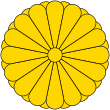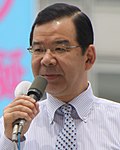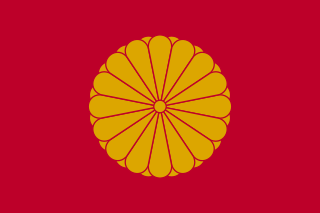
The politics of Japan are conducted in a framework of a multi-party bicameral parliamentary representative democratic constitutional monarchy whereby the Emperor is the ceremonial head of state and the Prime Minister is the head of government and the head of the Cabinet, which directs the executive branch.
Komeito, formerly called New Komeito, is a political party in Japan founded by members of the Nichiren Buddhist-based new religious movement Soka Gakkai. The party is sometimes called by its former name, Clean Government Party.

The New Frontier Party was a political party in Japan founded in December 1994. As a merger of several small parties, the party was ideologically diverse, with its membership ranging from moderate social democrats to liberals and conservatives. The party dissolved in December 1997, with Ichirō Ozawa's faction forming the Liberal Party and other splinters later joining the Democratic Party of Japan in April 1998.
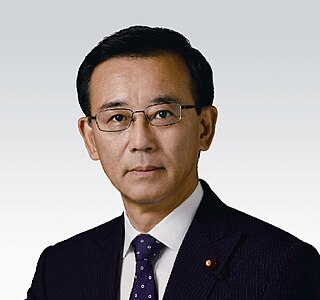
Sadakazu Tanigaki is a Japanese politician who served as Minister of Finance from 2003 to 2006 in the cabinet of Jun'ichirō Koizumi. He also served as Minister of Construction and Transport in the cabinet of Yasuo Fukuda and served his ninth term as a member of the House of Representatives, representing Kyoto's Fifth District. He was elected as President of the Liberal Democratic Party (LDP) on 28 September 2009, following the party's massive defeat in the 2009 general election. He was replaced by Shinzō Abe on 26 September 2012. He was only the second LDP leader who was not simultaneously Prime Minister of Japan.

A general election in Japan was held on 11 September 2005 for all 480 seats of the House of Representatives of Japan, the lower house of the Diet of Japan, almost two years before the end of the term taken from the last election in 2003. Prime Minister Junichiro Koizumi called the election after bills to privatize Japan Post were voted down in the upper house, despite strong opposition within his own Liberal Democratic Party (Japan) (LDP).

The People's New Party was a Japanese political party formed on August 17, 2005 in the aftermath of the defeat of Prime Minister Junichiro Koizumi's Japan Post privatisation bills which led to a snap election. On March 21, 2013 party leader Shozaburo Jimi announced that he was disbanding the party.

The New Party Nippon is a Japanese political party formed on August 21, 2005. The party is headed by the former Nagano governor Yasuo Tanaka, and includes Diet members Kōki Kobayashi, Takashi Aoyama, Makoto Taki, and Hiroyuki Arai, who left the Liberal Democratic Party in opposition to Prime Minister Junichiro Koizumi’s postal privatization drive.
This article presents detail of the results in the Japan general election, 2005, breaking down results by block district. The 11 block districts elected 180 members by proportional representation, and 300 members were elected from single-member districts distributed among the 47 prefectures.
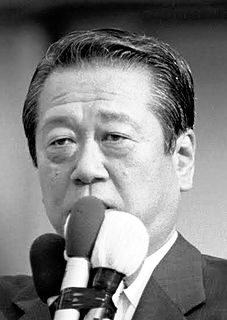
The 21st Elections to the House of Councillors for the upper house of the legislature of Japan were held on July 29, 2007. The date was originally to be July 22, but the ruling Liberal Democratic Party (LDP) decided in mid-June to extend the session of the House for a week to finish up legislative business; this step was criticised due to the short-term delay.

Elections for the Japanese House of Councillors were held in Japan on 29 July 2001. It was the first national election since Junichiro Koizumi was appointed as prime minister after Yoshiro Mori resigned in April 2001. The Liberal Democratic Party (LDP) and its election allies, were the major winner, provided Koizumi a strong mandates to move forward with his reform policies. The ruling coalition performed well, and regain their majority in the House of Councillors.

Elections for the Japanese House of Councillors were held in Japan on July 12, 1998.
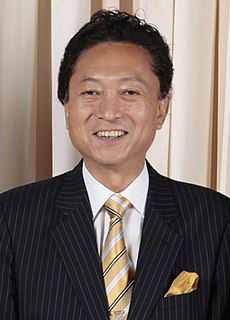
A general election for the Japanese House of Representatives was held on August 30, 2009. The opposition Democratic Party (DPJ) defeated the ruling coalition in a sweeping victory, winning 221 of the 300 electoral districts and receiving 42.4% of the proportional block votes for another 87 seats, a total of 308 seats to only 119 for the LDP.

A general election was held in Japan on 16 December 2012. Voters gave the Liberal Democratic Party a landslide victory, ejecting the Democratic Party from power after three years. It was the fourth worst defeat suffered by a ruling party in Japanese history.

The 22nd Elections to the House of Councillors for the upper house of the legislature of Japan were held on July 11, 2010. In the last election in 2007, the Liberal Democratic Party (LDP) lost its majority to the Democratic Party (DPJ), which managed to gain the largest margin since its formation in 1996. The House of Councillors is elected by halves to six-year terms. The seats up for election in 2010 were last contested in the 2004 election.

The 23rd Elections to the House of Councillors for the upper house of the National Diet, the legislature of Japan, was held on July 21, 2013. In the last election in 2010, the Democratic Party of Japan (DPJ) remained the largest party, but the DPJ-led ruling coalition lost its majority. The House of Councillors is elected by halves to six year terms. In 2013, the class of Councillors elected in 2007 was up.

Yamaguchi 4th district is a single-member electoral district for the House of Representatives, the lower house of the National Diet of Japan. It is located in Western Yamaguchi and consists of the cities of Shimonoseki and Nagato. As of September 2011, 266,456 voters were registered in the district, giving its voters well above average vote weight. Unlike many prefectures where the capital is also the most populous city, Yamaguchi's major city is Shimonoseki, located at the western tip of Honshū and part of the Fukuoka-Kitakyūshū metropolitan area.

The 47th general election of members of the House of Representatives of Japan was held on 14 December 2014. Voting took place in all Representatives constituencies of Japan including proportional blocks, in order to appoint Members of Diet to seats in the House of Representatives, the lower house of the National Diet of Japan. As the cabinet resigns in the first post-election Diet session after a general House of Representatives election, the lower house election also led to a new designation election of the prime minister in the Diet, and the appointment of a new cabinet. The turnout in this election is the lowest in Japanese history.
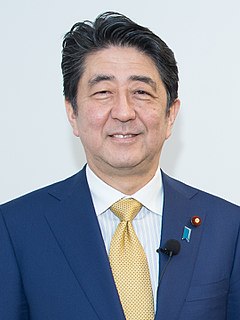
The 48th general election of members of the House of Representatives took place on 22 October 2017. Voting took place in all Representatives constituencies of Japan – 289 single-member districts and eleven proportional blocks – in order to appoint all 465 members of the House of Representatives, the lower house of the then 707-member bicameral National Diet of Japan. Incumbent Prime Minister Shinzō Abe's governing coalition of the Liberal Democratic Party (LDP) and Komeito retained their seats in light of what was perceived as weak opposition, winning his fourth term in office and holding on to the two-thirds supermajority in order to revise the war-renouncing Article 9 of the Japanese Constitution.
The Shikoku proportional representation block was one of 11 multi-member districts that were contested at the general election for the House of Representatives in the Japanese National Diet on 16 December 2012. Six seats were available for election via open party lists. The Liberal Democratic Party (LDP) won the election in a landslide, which returned former Prime Minister Shinzo Abe to power. In the Shikoku PR block, the LDP won two of the six seats with 30.7% of the vote.

